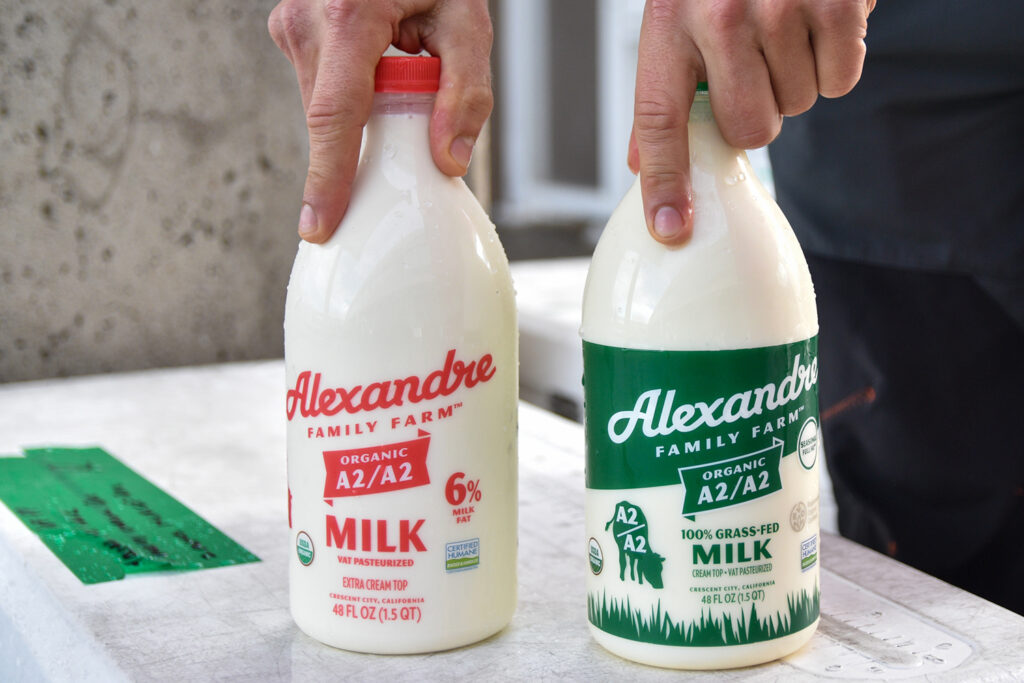Milk

Since humans began drinking the milk of domesticated mammals as long ago as 9000 BC, milk has held a special place in cultures the world over. Milk is referenced in numerous religious texts and stories, used in rituals, and was even attributed magical powers by some early societies. Today, in spite of the prevalence of lactose intolerance among adults, milk remains one of the most commonly consumed beverages, and still has a special, albeit different, place in many cultures. Generally milk comes from cows but many people drink the milk of other animals including camels, goats, sheep, horses, llamas, reindeer, and water buffalo. Cow’s milk, and milk from other animals, is also processed worldwide to make a variety of other delicious foods like butter, cream, yogurt, kefir, cheese, and ice cream.
The average dairy cow produces around nine gallons of milk per day, and each gallon is rich in nutrients like protein, calcium, phosphorous, potassium, magnesium, riboflavin, and vitamins C, D, E, K, B6, and B12. The diet of the cow affects the nutritional composition of the milk. The milk of pasture-fed animals is higher in linoleic acid and vitamin E than that of industrially raised animals, for example. The main variable in the composition of milk is the butterfat or milkfat content, which has a significant effect on taste and consistency. Fat content is determined by several factors both natural and artificial. The kind of animal, the specific breed, the diet, and the point in the lactation period when the animal is milked all affect the fat composition and taste of milk. To alter fat content after production, milkfat is removed then added back in at set levels to make the different types of milk commonly seen on shelves: whole, reduced fat, low fat, and skim or non-fat.
Typical processing for milk entails pasteurization to kill bacteria and pathogens, homogenization to create even texture, and sometimes fortification to add to nutritional value or replace those nutrients lost in production. Nearly all milk for sale in the US is pasteurized for health and safety. Because milk is such an ideal medium for bacterial growth it has historically been responsible for the transmission of diseases like tuberculosis, Salmonella, and E. coli. To prevent this, it became common practice for milk to undergo pasteurization, in which it is heated then quickly cooled again. Pasteurizing milk also extends its shelf life.
Currently, milk must be pasteurized to be shipped across state borders, presenting a problem for consumers who prefer raw milk, which is neither pasteurized nor homogenized. Advocates for raw milk consumption claim that the taste is sweeter and richer than pasteurized milk and also attribute to it a number of health benefits, such as strengthening the immune system and providing relief from allergies and asthma. Though the FDA strongly advises against drinking raw milk, especially for children, pregnant women, and those with compromised immune systems, it is legal to sell in some states, including California.
Milk is also categorized by grade, which is used by manufacturers to identify quality, to establish wholesale prices, and to provide choices to customers. Most milk for sale in stores for direct consumption is Grade A, while Grade B is more commonly used for indirect consumption such as processing into cheeses. Grade A indicates the wholesomeness and safety with which the milk was produced, not the quality. The conditions under which it is processed and handled are strictly monitored and regulated by state and local sanitation officials.
Although milk is already one of the most highly regulated foods, more producers, driven by consumer demand, are producing certified organic milk, which is subject to still more rigorous USDA inspections and controls than conventional milk. While organic milk is not nutritionally much different than conventional milk, it can be much better from the standpoint of animal welfare and environmental stewardship. UDSA organic milk regulations specify that all cows must graze in a pasture for at least four months out of the year (many farms do more), farms must use organic fertilizers and pesticides, cows must be fed only organic (non-GMO) feed, and no antibiotics or hormonal supplements can be given.
In conventional operations, the most common hormonal supplement given to cows is recombinant bovine somatotropin (rBST), a synthetic version of a naturally occurring hormone that increases milk production, which is not given to cows producing organic milk. To obtain and keep organic certification farms undergo annual on-site inspections and have their milk tested for antibiotic and pesticide residue. Conventional milk is also heavily regulated for health and safety, but less attention may be given to the welfare of the animals and the environmental impact.
Milk is a delicious and healthy addition to many people’s diets. It is affordable, easy to come by, safe, and has a long shelf life when refrigerated promptly after purchase. Milk gone bad has a sour smell, while good milk has little to no scent. Depending on the type of milk, look for a white (grain-fed cows) to yellowish (pasture-fed cows) color but never grayish or blue.
